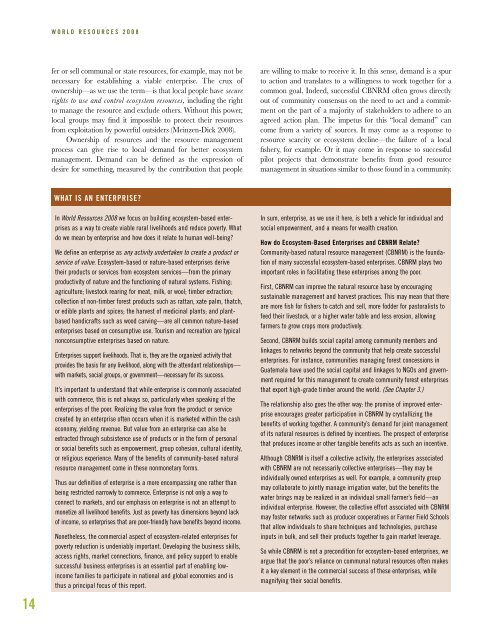Growing the Wealth of the Poor - World Resources Institute
Growing the Wealth of the Poor - World Resources Institute
Growing the Wealth of the Poor - World Resources Institute
You also want an ePaper? Increase the reach of your titles
YUMPU automatically turns print PDFs into web optimized ePapers that Google loves.
W O R L D R E S O U R C E S 2 0 0 8fer or sell communal or state resources, for example, may not benecessary for establishing a viable enterprise. The crux <strong>of</strong>ownership—as we use <strong>the</strong> term—is that local people have securerights to use and control ecosystem resources, including <strong>the</strong> rightto manage <strong>the</strong> resource and exclude o<strong>the</strong>rs. Without this power,local groups may find it impossible to protect <strong>the</strong>ir resourcesfrom exploitation by powerful outsiders (Meinzen-Dick 2008).Ownership <strong>of</strong> resources and <strong>the</strong> resource managementprocess can give rise to local demand for better ecosystemmanagement. Demand can be defined as <strong>the</strong> expression <strong>of</strong>desire for something, measured by <strong>the</strong> contribution that peopleare willing to make to receive it. In this sense, demand is a spurto action and translates to a willingness to work toge<strong>the</strong>r for acommon goal. Indeed, successful CBNRM <strong>of</strong>ten grows directlyout <strong>of</strong> community consensus on <strong>the</strong> need to act and a commitmenton <strong>the</strong> part <strong>of</strong> a majority <strong>of</strong> stakeholders to adhere to anagreed action plan. The impetus for this “local demand” cancome from a variety <strong>of</strong> sources. It may come as a response toresource scarcity or ecosystem decline—<strong>the</strong> failure <strong>of</strong> a localfishery, for example. Or it may come in response to successfulpilot projects that demonstrate benefits from good resourcemanagement in situations similar to those found in a community.14WHAT IS AN ENTERPRISE?In <strong>World</strong> <strong>Resources</strong> 2008 we focus on building ecosystem-based enterprisesas a way to create viable rural livelihoods and reduce poverty. Whatdo we mean by enterprise and how does it relate to human well-being?We define an enterprise as any activity undertaken to create a product orservice <strong>of</strong> value. Ecosystem-based or nature-based enterprises derive<strong>the</strong>ir products or services from ecosystem services—from <strong>the</strong> primaryproductivity <strong>of</strong> nature and <strong>the</strong> functioning <strong>of</strong> natural systems. Fishing;agriculture; livestock rearing for meat, milk, or wool; timber extraction;collection <strong>of</strong> non-timber forest products such as rattan, xate palm, thatch,or edible plants and spices; <strong>the</strong> harvest <strong>of</strong> medicinal plants; and plantbasedhandicrafts such as wood carving—are all common nature-basedenterprises based on consumptive use. Tourism and recreation are typicalnonconsumptive enterprises based on nature.Enterprises support livelihoods. That is, <strong>the</strong>y are <strong>the</strong> organized activity thatprovides <strong>the</strong> basis for any livelihood, along with <strong>the</strong> attendant relationships—with markets, social groups, or government—necessary for its success.It’s important to understand that while enterprise is commonly associatedwith commerce, this is not always so, particularly when speaking <strong>of</strong> <strong>the</strong>enterprises <strong>of</strong> <strong>the</strong> poor. Realizing <strong>the</strong> value from <strong>the</strong> product or servicecreated by an enterprise <strong>of</strong>ten occurs when it is marketed within <strong>the</strong> casheconomy, yielding revenue. But value from an enterprise can also beextracted through subsistence use <strong>of</strong> products or in <strong>the</strong> form <strong>of</strong> personalor social benefits such as empowerment, group cohesion, cultural identity,or religious experience. Many <strong>of</strong> <strong>the</strong> benefits <strong>of</strong> community-based naturalresource management come in <strong>the</strong>se nonmonetary forms.Thus our definition <strong>of</strong> enterprise is a more encompassing one ra<strong>the</strong>r thanbeing restricted narrowly to commerce. Enterprise is not only a way toconnect to markets, and our emphasis on enterprise is not an attempt tomonetize all livelihood benefits. Just as poverty has dimensions beyond lack<strong>of</strong> income, so enterprises that are poor-friendly have benefits beyond income.None<strong>the</strong>less, <strong>the</strong> commercial aspect <strong>of</strong> ecosystem-related enterprises forpoverty reduction is undeniably important. Developing <strong>the</strong> business skills,access rights, market connections, finance, and policy support to enablesuccessful business enterprises is an essential part <strong>of</strong> enabling lowincomefamilies to participate in national and global economies and isthus a principal focus <strong>of</strong> this report.In sum, enterprise, as we use it here, is both a vehicle for individual andsocial empowerment, and a means for wealth creation.How do Ecosystem-Based Enterprises and CBNRM Relate?Community-based natural resource management (CBNRM) is <strong>the</strong> foundation<strong>of</strong> many successful ecosystem-based enterprises. CBNRM plays twoimportant roles in facilitating <strong>the</strong>se enterprises among <strong>the</strong> poor.First, CBNRM can improve <strong>the</strong> natural resource base by encouragingsustainable management and harvest practices. This may mean that <strong>the</strong>reare more fish for fishers to catch and sell, more fodder for pastoralists t<strong>of</strong>eed <strong>the</strong>ir livestock, or a higher water table and less erosion, allowingfarmers to grow crops more productively.Second, CBNRM builds social capital among community members andlinkages to networks beyond <strong>the</strong> community that help create successfulenterprises. For instance, communities managing forest concessions inGuatemala have used <strong>the</strong> social capital and linkages to NGOs and governmentrequired for this management to create community forest enterprisesthat export high-grade timber around <strong>the</strong> world. (See Chapter 3.)The relationship also goes <strong>the</strong> o<strong>the</strong>r way: <strong>the</strong> promise <strong>of</strong> improved enterpriseencourages greater participation in CBNRM by crystallizing <strong>the</strong>benefits <strong>of</strong> working toge<strong>the</strong>r. A community’s demand for joint management<strong>of</strong> its natural resources is defined by incentives. The prospect <strong>of</strong> enterprisethat produces income or o<strong>the</strong>r tangible benefits acts as such an incentive.Although CBNRM is itself a collective activity, <strong>the</strong> enterprises associatedwith CBNRM are not necessarily collective enterprises—<strong>the</strong>y may beindividually owned enterprises as well. For example, a community groupmay collaborate to jointly manage irrigation water, but <strong>the</strong> benefits <strong>the</strong>water brings may be realized in an individual small farmer’s field—anindividual enterprise. However, <strong>the</strong> collective effort associated with CBNRMmay foster networks such as producer cooperatives or Farmer Field Schoolsthat allow individuals to share techniques and technologies, purchaseinputs in bulk, and sell <strong>the</strong>ir products toge<strong>the</strong>r to gain market leverage.So while CBNRM is not a precondition for ecosystem-based enterprises, weargue that <strong>the</strong> poor’s reliance on communal natural resources <strong>of</strong>ten makesit a key element in <strong>the</strong> commercial success <strong>of</strong> <strong>the</strong>se enterprises, whilemagnifying <strong>the</strong>ir social benefits.
















